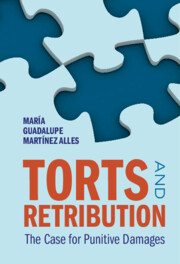Book contents
- Torts and Retribution
- Torts and Retribution
- Copyright page
- Dedication
- Epigraph
- Contents
- Preface
- Acknowledgments
- Introduction
- Part I The Place of Punishment in Torts
- Part II The Retributive Rationale
- 3 The Punitive Puzzle
- 4 Relational Retribution
- 5 Overcoming Compensatory Reductionism
- Part III Retribution in the Mass-Market Setting
- Part IV Why Tort Law
- Bibliography
- Index
4 - Relational Retribution
from Part II - The Retributive Rationale
Published online by Cambridge University Press: 09 August 2025
- Torts and Retribution
- Torts and Retribution
- Copyright page
- Dedication
- Epigraph
- Contents
- Preface
- Acknowledgments
- Introduction
- Part I The Place of Punishment in Torts
- Part II The Retributive Rationale
- 3 The Punitive Puzzle
- 4 Relational Retribution
- 5 Overcoming Compensatory Reductionism
- Part III Retribution in the Mass-Market Setting
- Part IV Why Tort Law
- Bibliography
- Index
Summary
This chapter drills deeply into the compelling reconstruction that equates the purpose of punitive damages with “retribution and deterrence.” It articulates a justificatory account of the retributive character of punitive damages that responds to the relational significance of the role the victim plays in expressing condemnation and to the importance of maintaining institutional modes of moral communication for value affirmation between the private parties involved in tortious situations. The main argument is that retribution in torts is relational. Relational Retribution offers a holistic account of retribution that recognizes the necessary interconnection between the reprehensible character of the defendant’s conduct as deserving of punishment and the rich correlative retributive motivations of the victim of seriously disrespectful actions seeking the imposition of the punitive award. This relational approach transcends the unilateral focus on the reprehensibility of the defendant’s behavior and the notion of “just deserts” for the imposition of a monetary sanction. Alternative motives for retribution such as “denunciation” and “value affirmation” often more accurately explain the victim’s resolve. Because of the centrality of proportionality in any retributive theory of punishment, the chapter ends by sketching out the principle of sanction proportionality under the framework of Relational Retribution.
Keywords
Information
- Type
- Chapter
- Information
- Torts and RetributionThe Case for Punitive Damages, pp. 122 - 149Publisher: Cambridge University PressPrint publication year: 2025
Accessibility standard: WCAG 2.0 AA
Why this information is here
This section outlines the accessibility features of this content - including support for screen readers, full keyboard navigation and high-contrast display options. This may not be relevant for you.Accessibility Information
Content Navigation
Allows you to navigate directly to chapters, sections, or non‐text items through a linked table of contents, reducing the need for extensive scrolling.
Provides an interactive index, letting you go straight to where a term or subject appears in the text without manual searching.
Reading Order & Textual Equivalents
You will encounter all content (including footnotes, captions, etc.) in a clear, sequential flow, making it easier to follow with assistive tools like screen readers.
Structural and Technical Features
You gain clarity from ARIA (Accessible Rich Internet Applications) roles and attributes, as they help assistive technologies interpret how each part of the content functions.
